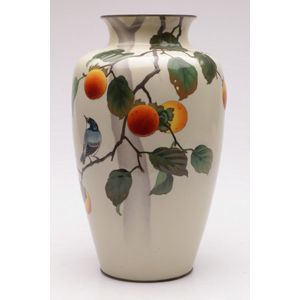
Blue Bird Moriage Cloisonne Vase by Gonda Hirosuke
Gonda Hirosuke Moriage cloisonne vase depicting a small blue bird on a Percimmon branch, makers mark to base, height 31 cm Condtion - good/fair - small hairline crack to shoulder

Meiji Moriage and Ginbari Cloisonne Vase with Goldfish
A Japanese Moriage and Ginbari cloisonne vase, Meiji period (1868-1912), decorated with goldfish in ginbari against a deep green ground with moriage netting superimposed. Mount Fuji mark to the base. 15.5 cm high, 7 cm diameter

Meiji period cloisonne vase with fish decoration
A cloisonne vase, late Meiji period, decorated in low relief (moriage) and wireless (musen) technique with a red and a dark grey carp swimming in rippling water on one side and another pale grey fish on the reverse, all reserved on the pale green ground,…

Japanese Enamel Plaque: Mount Fuji at Dawn
A Japanese wireless enamel rectangular plaque depicting the upper slopes of Mount Fuji, rising above dawn clouds in a moriage style against a skyline of bronze metal, in the manner of Ando Shippo Ten (Ando Cloisonne Shop). 27.5 x 38 cm, printed label and…

Japanese Mount Fuji Enamel Plaque
A Japanese wireless enamel rectangular plaque depicting the upper slopes of Mount Fuji, rising above dawn clouds in a moriage style against a skyline of bronze metal, in the manner of Ando Shippo Ten (Ando Cloisonne Shop). 29 x 39.5 cm.

Moriage Cloisonne Koi Carp Vase, Meiji Period
A moriage cloisonne enamel vase, Meiji period (c.1900), in style of the workshop of Gonda Hirosuke (1865-1937), tapering shouldered form and slightly flared neck, decorated in raised relief with three koi carp swimming through ripples, all against a pale…

Moriage Cloisonne Fish and Lily Vase with Silver Mounts
Ando Jubei Moriage vase of rounded rectangular tapered form encircled with a design of fish swimming below flowering lillies against a pale grey ground. Of cloisonne enamels with silver mounts. The design executed in moriage relief, with silver wire, as…

Gonda Cloisonne Vase with Carp Decoration
Japanese Gonda cloisonne vase. Moriage decoration of two carp in dark blue water. Stamped to base, circa 1920s. Height 19 cm
 Loading more...
Loading more...